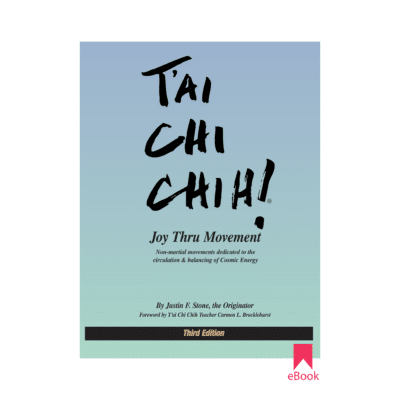
For the beginning student the most important aspect is to learn how to move. It is of utmost importance that T’ai Chi Chih be practiced correctly in accordance with the principles of yin-yang so that results will be maximized. Knowing where to place the arms and feet will come easily, but eager students often try too hard and use considerable effort, causing tension when T’ai Chi Chih must be tension-free. Any tension will keep the Chi (Intrinsic Energy) from flowing freely through the meridian channels.
The student must not think of T’ai Chi Chih as “exercise.” In truth it is the best exercise I know, since it exercises the internal organs and does not tire one but tends to increase energy. However, it is all-important that T’ai Chi Chih be done softly, without effort—what we call “the effort of no effort.”
If you will remember to think of yourself as moving slow motion in a dream or slowly swimming through heavy air, yet without exertion, you will have the idea of how to move. The movements are not done rhythmically like a dance. Long, sweeping, “graceful” movements are apt to be all yin or all yang, thus negating the practice. Rather, the motions are performed almost leisurely as though the relaxed student is more of an onlooker than a participant.
The correct posture is that of standing with the tailbone pressed slightly forward, and the tan t’ien (two inches below the navel) compressed against the backbone. The shoulders are relaxed and drooping, and the hands and wrists (more than the arms) move in soft, circular motions. “Softness and continuity” are necessary. Nice and even, like the chewing of food, is one description the ancient teachers used. Breathing is natural.
The practicer must keep his or her concentration in the soles of the feet (easy) or on the spot two inches below the navel (more difficult) while doing the movements. The “Heart Fire” (the yang of the heart, corresponding to the yang of the sun) should be brought down; otherwise the yin of the kidneys (corresponding to the yin of the moon) will rise. It is not desirable to have the water section floating upward. The great benefits in health, increased energy and serenity come from bringing the Heart Fire down as the Chi circulates. When the reader becomes familiar with the practice, these points will become clear.
There are three confirming signs in learning and practicing T’ai Chi Chih: first, the practicer will note that his or her fingers begin to tremble a bit while moving; perhaps friends may call attention to this. It means the Intrinsic Energy is now flowing freely.
Secondly, after some time, the student may be doing T’ai Chi Chih one day and suddenly notice that nobody is doing anything, that T’ai Chi Chih is doing T’ai Chi Chih. (This first happened to me in a Japanese garden, and it is a joyous experience.)
Thirdly, after some years of practice one may notice that he or she can do the form mentally. With eyes closed one can visualize the movements and will feel the flow of the Chi, the Vital Force, just as though there were physical movements. So you can be sitting on a plane or attending a boring lecture and, with eyes closed, be enjoying T’ai Chi Chih. This will take considerable time and faithfulness in practice.
To say that practice, preferably daily practice—early in the morning seems the best time, but some people also do it late in the afternoon—is necessary is to point out the obvious. But that practice must be done softly and continuously, preferably at a slow pace. If you rush you will cut the movements short. The yinning and yanging, the bending of the knees and the shift of weight to the bent knee (a slow, steady shift) is all-important, but it must be done softly and evenly.
To sum up: softness at all times, slow and even movements, and no effort; these comprise the “musts” of T’ai Chi Chih movements. Try to observe them at all times.

